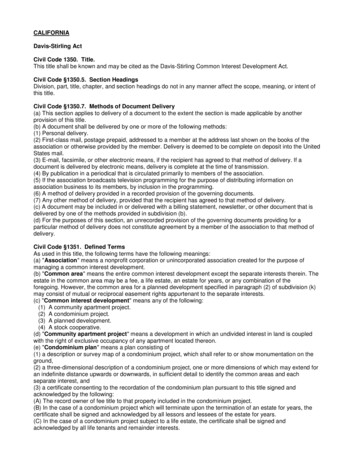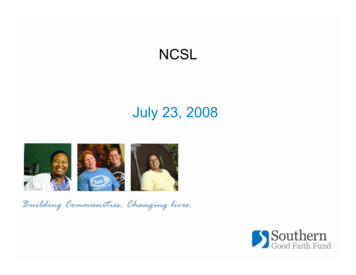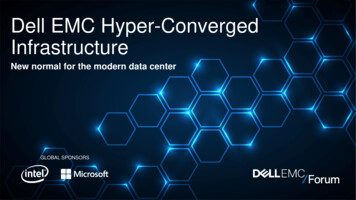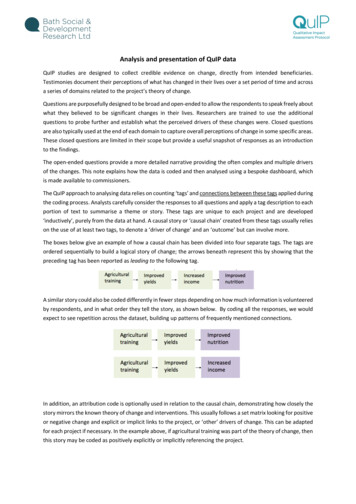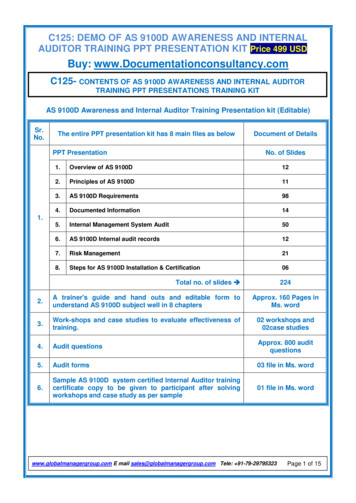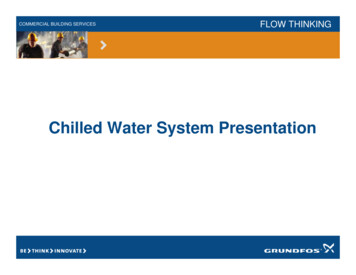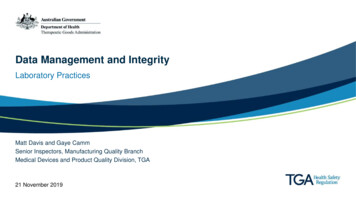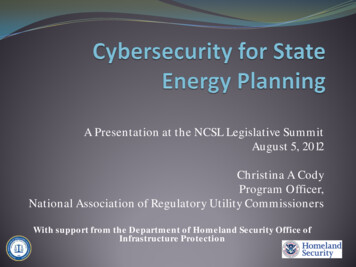
Transcription
A Presentation at the NCSL Legislative SummitAugust 5, 2012Christina A CodyProgram Officer,National Association of Regulatory Utility CommissionersWith support from the Department of Homeland Security Office ofInfrastructure Protection
Cybersecurity is one element of allhazards preparedness
Why Cyber? (cont’d.)— Ubiquity of networks and dependency on them— A network is cheaper, faster, more effective, andultimately enhances reliability— Ease of launching a sophisticated attack— Tools are freely available on the Internet (e.g.Metasploit)— Industry reliance on commercial software— Evolution toward distributed networks— Interdependencies between sectors
Why Cyber?— In a 2011 Symantec survey, 71% of the organizations polled had come underdeliberate cyber-attack in the last 12 months.Figure 1 Data source: IBM X-Force 2010 Trend and Risk Report (for the IT and Telecom os/manyeyes/visualizations/vulerabilities-per-year
Threats and Vulnerabilities— Threat: The potential for an actor, circumstance or event toadversely affect assets, people or organizational operationsof the system.— Vulnerability: A specific weakness in an informationsystem, system security procedures, internal controls orimplementation that could be exploited or triggered by athreat source.
Cyber Attacks Exist on a ContinuumLow impact:— Nuisance – low consequence— Routine cyber attack common to all business networks— Usually easier to detect and defend againstIntermediate impact:— Events that may involve damage to a single system component— Unsophisticated, unstructuredHigh impact:— Directed against multiple assets designed to disable the system— Highly-coordinated, well-planned— Advanced Persistent Threat
Three FlavorsConventionalIT Systems Control Systems ElectricalInfrastructure “Smart Grid”
Interdependencies— A pretty bad hypothetical scenario
A very real threat— April / May 2007: Estonian economy largely shut down by cyber attacks———————originating in Russia over the relocation of a statueIn April 2009, the Wall Street Journal stated Chinese and other spieshacked into the U.S. electric grid and left behind computer programs thatcould allow them to disrupt service (since discredited)2009 cyber attacks on nation of Georgia prompted NATO commentsAurora: an experiment to hack control systems and destroy a generatorstaged by the DOE and DHS; revealed by CNNSTUXNET: computer worm created to attack Iran’s nuclear infrastructure –only attacked designated targetsFlame: out since at least 2010, discovered 2012, the most sophisticated of itskindMarch 2012 cyber attack targeted US and Canadian natural gas pipelines’computer systemsIn 2011 a malfunctioning water pump in Illinois was accessed fromRussia, prompting cyber attack fears (since discredited)** Note: even attacks that have been discredited do not mean that the vulnerability did notexist there: the attacks were credible enough to be reported.
National Attention / StateResponsibility— What’s missing?— Enforceable Cybersecurity Rules for Distribution(though some States have led in this area)— Metrics for cybersecurity— PUC/PSC cybersecurity expertise (emerging)— Legislation— It may fall to State Commissions to ask questions andrequire performance
States’ Planning— Cyber attack has physical consequences— Where do state legislators come in?— Executive branch oversight responsibility————Talk to state agencies – and who else? Know the playersInternal networks vs. Industry sectorsPublic/Private partnership perspectiveWorking relationship with enterprise security side of operations— Understand the lay of the land – what’s the reality in yourstate?— Appropriations— “Cybersecurity at home”— State energy assurance plans
What State Regulators Are Doing— These are increasingly drivers for cost recovery consideration and othercontexts in cases— NERC CIP compliance is driving new expenditures by utilities, but it isnot exhaustive— Regulators are filling needed roles where NERC CIP does not cover,such as in the area of distribution— The deployment of smart grid increases instances— California— Approved Smart Grid metrics (including cybersecurity)— Ohio— Heavily involved in NIST SGIP Cyber Security Working Group activities— Chair NARUC Staff Subcommittee on Critical Infrastructure— Texas— Staff dedicated almost solely to cybersecurity— Participation in various energy sector cybersecurity initiatives
Asking Questions— The questions are only as good as your ability tounderstand the answers and take intelligent action— Sample Approaches to Information Protection— “We can’t protect it so don’t share it”— “We can’t protect it onsite but can see it at your site”— “We can protect it in a special case”— “We can protect it within a standard case with a securehearing”— “We can protect it as a matter of course”
Department of Hurricanes—————Cyber secure utility operations is the domain ofutilitiesDefending against nation-state cyber attacks andcyber terrorism are national defense and lawenforcement mattersEffective cyber security takes utility/regulator /federal agency (DHS, etc.) partnershipAgencies like DOE (OE) and DHS are working onthis issue,But, we don’t have a Department of Hurricanes
Compliance to Standards vs. RiskBased Assessment— Prevention - Protection – Recovery— Mature security practices; highly refined— Defense in Depth— Principle of Least Privilege— Segregation of Duties— Need to Know— Maintain Confidentiality, Integrity, Availability— No such thing as 100% Total Security, nor is there a silverbullet— Strong protection has never been easy, inexpensive or quickto implement— There may be a tradeoff between functionality and security
Dynamic Defense— Evolving threat, evolving defense— Defense in Depth— Principle of Least Privilege— Segregation of Duties— Need to Know— Maintain Confidentiality, Integrity, Availability— No golden shield, no silver bullet— Strong protection has never been easy, inexpensive orquick to implement— There may be a tradeoff between functionality andsecurity
Dynamic Defense (cont’d.)— If defensive measures can be beaten, the systemshould ensure the results of the attack are:— Limited in consequence - protect the network if a——————component is lostUnprofitable for attackerHard enough to make the “juice” not worth the“squeeze”Difficult to replicateQuickly and easily recoverableTraceable and easy to detectOtherwise unappealing
What States Can Do— Understand the State’s internal cybersecurity profile— Understand the current cybersecurity requirementsfor the energy sector— Determine whether there are cyber security plans inplace, and whether they are driven by State regulatoryor Federal grants compliance.— Consider and address the human element— Understand future guidelines and standards underconsideration and how they affect the grid’s futuresplans
Step One – Understand the State’sinternal cybersecurity profile.1.2.3.4.5.6.7.Understand cybersecurity risks at work and at home. Many States haveguidance available. For an example see:http://www.michigan.gov/cybersecurity.Identify the cybersecurity roles and responsibilities of individuals andorganizations in State government.Determine which State agency, if any, has lead and/or supporting roles andresponsibilities in cybersecurity for smart grid implementation.Know what the State’s Continuity of Operations Plans (COOP) and disasterrecovery strategies are for essential IT systems.Determine if it may be helpful to become a member of the FBI’s InfraGardProgram: http://www.infragard.net/.Become familiar with the U. S. Computer Emergency Readiness Team (USCERT), which provides response support and defense against cyber attacksfor the Federal Civil Executive Branch, as well as information sharing andcollaboration http://www.fema.gov/government/coop/index.shtmThe SANS (SysAdmin, Audit, Network, Security) Institute is a good resourcesee: http://www.sans.org/reading room/whitepapers/recovery/
Step Two – Understand current cybersecurity forthe energy sector.1.Electricity and smart grid:——2.3.NERC -- Standards CIP-002 through CIP-009 (the Critical Cyber Asset Identificationportion of the Critical Infrastructure Protection StandardsSection 1305 of Energy Independence and Security Act (EISA) 2007 defines the roles ofboth Federal Energy Regulatory Commission and NIST as they relate to the developmentand adoption of smart grid standards. The Act defines the Commission’s role as: “At anytime after the Institute’s work has led to sufficient consensus in the Commission’sjudgment, the Commission shall institute a rulemaking proceeding to adopt suchstandards and protocols as may be necessary to insure smart-grid functionality andinteroperability in interstate transmission of electric power, and regional and wholesaleelectricity markets.”Understand the cybersecurity requirement for other parts of the energysector including natural gas (pipeline safety standards) and the petroleumsector, because of the interdependency effects that need to be considered.Under EISA 2007, NIST has "primary responsibility to coordinatedevelopment of a framework that includes protocols and model standardsfor information management to achieve interoperability of smart griddevices and systems "———One of the primary documents was issued in January 2010 and titled Framework andRoadmap for Smart Grid Interoperability Standards, Release 1.0 (Framework).”The Framework identified 75 interoperability standards that are applicable, or are likelyapplicable, to the ongoing development of smart grid technologies and applications.NIST developed Guidelines for Smart Grid Cyber Security.
Step Three – Understand future standards andguidelines currently under discussion anddevelopment1.2.The Advanced Security Acceleration Project for the Smart Grid(ASAP-SG) is a utility-driven, public-private collaborative among DOE,EPRI, and a large group of leading North American utilities. ASAP-SGis developing system-level security requirements for smart gridapplications, such as advanced metering, third party access forcustomer usage data, distribution automation, home area networks,and synchrophasors.Over the next three years, the National Electric Sector Cyber SecurityOrganization (NESCO) will be working with the National ElectricSector Cyber Security Organization Resources (NESCOR) to lead abroad-based, public-private partnership to improve electric sectorenergy systems cybersecurity
Step Four – Are there cybersecurity plans in place currently? Arethey driven by State regulation, Federal grants compliance orother mechanisms?1.2.3.4.5.Which requirements are Standards-driven? Which are not?Are there regulatory efforts underway at a State public utilitycommission to create audit, reporting and compliance obligations oncybersecurity for the utilities?Are there State policies and programs that address cybersecurity?How is your State approaching the public private partnerships asprovided for in the National Infrastructure Protection Plan (DHS) andthe Energy Sector Specific Plan (DHS and DOE)The ARRA Smart Grid Investment Grants program requires utilities todevelop cyber security plans. These Grants require:——————A description of the cybersecurity risks at each stage of the system deploymentlifecycle.Cybersecurity criteria used for vendor and device selection.Cybersecurity control strategies.Descriptions of residual cybersecurity risks.Relevant cybersecurity standards and best practices.Descriptions of how the projects will support/adopt/implement emerging smartgrid security standards.
Step Five – Consider and address thehuman element of cyber security1.2.3.4.5.Understand what the insider threat is and what policies andprocedures are in place to prevent intrusion and manipulation.Understand what social engineering is and how it can be used toaccess systemsUnderstand that technical solutions to security should account forhuman behavior, which can be driven by both cultural andpsychological factors.Understand the nature of the threat from employees, contractors,consultants, or anyone with short or long term access to IT systems,and know about system vulnerabilities.Once this information has been developed it can be included ineither: (1) the States emergency electrical response plans as it relatesto how the private and public sector would respond to a cyber attack.(2) Longer term infrastructure assurance plans ( policy and programs)for reducing risks and vulnerabilities to cyber attack on the EnergySector.
Personnel— Deliberate vs. Inadvertent Breach—Software Bugs; User Errors; Power System EquipmentMalfunctions; Communications Equipment Failure—Deliberate Intrusions and Sabotage— Committing staff as a resource— Training— State Regulators don’t need to be cyber experts, but:— They must know what questions to ask a utility (they willreturn with answers!)— Security theater is a waste of money— Technology alone won’t solve the problem – people areintegral to security
Available Resources— Standards and Guidelines:— Bulk Power System: NERC CIP Standards— Smart Grid: NIST Interagency Report 7628 (NISTIR .html— NARUC has developed:— Cybersecurity for State Regulators with Sample Questions for Regulators to �� NARUC Critical Infrastructure Committeehttp://www.naruc.org/committees.cfm?c 46— Monthly Cybersecurity Threat Briefings— National Electric Sector Cyber Security Organization (NESCO): EnergySecformed the NESCO organization as a Public-private partnership includingUtilities, federal agencies, regulators, researches, and academics— National Electric Sector Cyber Security Organization Resource(NESCOR): EPRI was selected to serve as a research and analysis resource tothe NESCO program and develop mitigation strategies, best practices andmetrics— DOE Smart Grid Investment Grant (SGIG) Program: Required grantrecipients to gather info and implement cyber security mart-grid/recovery-actsmart-grid-investment-grants
Available Resources (cont’d.)— NASEO Smart Grid Report— NARUC Primer— AMI-SEC Task Force Advanced Metering Infrastructure (AMI) System SecurityRequirements, December 2008. FIPS-PUB-199-final.pdf.— ANSI/ISA-99, Manufacturing and Control Systems Security, Part 1: Concepts,Models and Terminology, 2007. FIPSPUB-199-final.pdf.— ANSI/ISA-99, Manufacturing and Control Systems Security, Part 2: Establishinga Manufacturing and Control Systems Security Program, 2009. FIPS-PUB-199-final.pdf.— Federal Bureau of Investigation, InfraGard program, InfraGard FBI CyberSecurity Collaboration. See http://www.infragard.net/.— Federal Information Processing Standard (FIPS) 200, Minimum SecurityRequirements for Federal Information and Information Systems, March 2006.See S-200-final-march.pdf.— FIPS 199, Standards for Security Categorization of Federal Information andInformation Systems, February 2004. FIPS-PUB-199-final.pdf.
Available Resources (cont’d.)— Idaho National Laboratory, Cyber Assessment Methods for SCADA————Security, 2005. ersecurity/SCADASecurity.pdf.National Institute of Standards and Technology (NIST) SpecialPublication (SP), 800-39, DRAFT Managing Risk from InformationSystems: An Organizational Perspective, April 2008. /SP800-39-spdsz.pdf.North American Electric Reliability Corporation (NERC), SecurityGuidelines for the Electricity Sector: Vulnerability and Risk Assessment,June 2002. See SPUB-199-final.pdf.Smart Grid Cyber Security Blog Spot. Seehttp://smartgridsecurity.blogspot.com/.U.S. Department of Homeland Security National InfrastructureProtection Plan, 2009. See http://www.dhs.gov/nipp.
Available Resources (cont’d.)— U.S. Department of Homeland Security IT, telecommunications, and————energy sectors sector specific plans (SSPs), and updated tri-annually.See http://www.dhs.gov/files/programs/gc 1179866197607.shtmU.S. Department of Energy (DOE) Office of Electricity Delivery andEnergy Reliability (OE) and the Energy Sector Control SystemsWorking Group, Roadmap to Achieve Energy Delivery SystemsCybersecurity, September 2011. See /09/Energy Roadmap.pdfU. S. Computer Emergency Readiness Team (US-CERT), U.S.Department of Homeland Security. See http://www.us-cert.gov/.American Petroleum Institute Security Guidelines for the PetroleumIndustry, April 2005. curity.pdfIdaho National Engineering and Environmental Laboratory AComparison of Oil and Gas Segment Cyber Security Standards,November 2004. ersecurity/Comparison of Oil and Gas Security.pdf
Thank you!Questions?Christina CodyProgram Officer, Grants and ResearchNARUCccody@naruc.org(202) 898-2200, ext. 1002U. S. Department of Homeland Security Office ofInfrastructure Protection
The SANS (SysAdmin, Audit, Network, Security) Institute is a good resource . Section 1305 of Energy Independence and Security Act (EISA) 2007 defines the roles of . (NESCOR) to lead a broad-base
